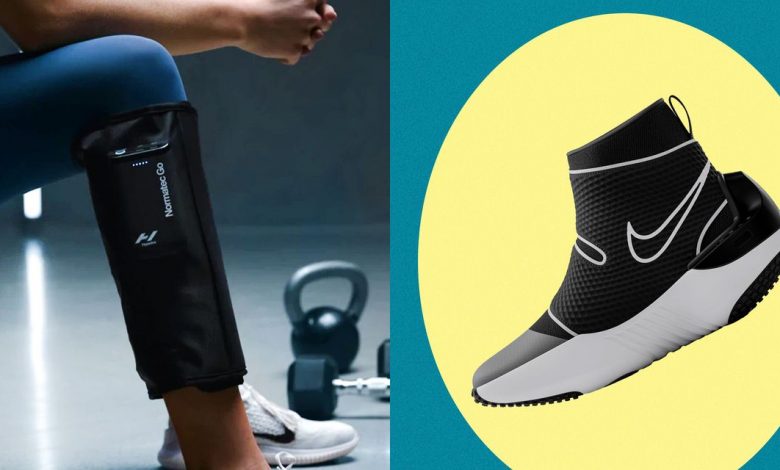Your Legs Are Begging You to Invest in Compression Boots

All products featured on Self are independently selected by our editors. However, we may receive compensation from retailers and/or from purchases of products through these links.
Some wellness tools (like the humble foam roller) are available at approachable price points, while others, well, aren’t. So, we’ll make this very clear: The best compression boots are not cheap. But, if you’re willing to splurge a little, these recovery tools can boost your circulation and help your legs feel fresher after tough workouts.
“Really any type of exercise or activity that is very leg-dominant and tends to lead to leg soreness can be helped by wearing some compression boots,” Danny King, PT, the national director of recovery and performance at Life Time, tells SELF, explaining that they work by inflating and deflating different parts of their shaft to apply pressure at set times, in a process known as dynamic pneumatic compression. “[Compression boots are] very commonly used in running and other endurance sports,” he explains, adding that their popularity is increasing among general strength trainers too. “As access improves, I believe we will see more and more people using them.”
Curious what compression boots can do for you and your recovery time? Check out the most investment-worthy pairs below, then read on to learn more about their potential benefits.
Our top picks
- Best Full-Length: Hyperice Normatec 3 Legs, $899
- Best for Lower Legs: Hyperice Normatec Go, $379
- Best for Travel: Therabody JetBoots Prime, $550
- Best for Feet: Nike x Hyperice Boot, $899
Shop the best compression boots
Meet your new main squeeze.
Best Full-Length: Hyperice Normatec 3 Legs
“I am probably biased, but Normatec Boots really can’t be beat,” King says (Life Time has a longtime partnership with Hyperice). Christa Sgobba, SELF’s director of fitness and food, agrees. “I use [these] at my physical therapist’s office, and they’re really great because they hit more problem areas (feet and ankles for me, and also hammies and quads),” she says.
The Normatec 3 Legs has five overlapping compression zones within its leg sleeves, so it can provide more targeted pressure to a specific area if you want. Its pressure settings and other controls are easy to navigate and adjust—we reviewed an older version a couple years ago, and when the 3 launched we noted that the remote was one of its most meaningful improvements. It’s sleek and streamlined, so you can access Normatec’s soothing air compression massage with ease.
Sizes: Small (for heights 5’3” and under), standard (for heights 5’4” to 6’3”), and large (for heights 6’4” and taller) | Weight: 8.15 pounds (boots, remote control, hose, and charger combined) | Compression levels: 7 levels (30 mmHg to 100 mmHg) | Battery life: 3 hours
Best for Lower Legs: Hyperice Normatec Go
Sgobba uses these calf-length sleeves at home. They don’t provide the same all-over compression as Normatec’s 3 Legs, but calf-specific compression is great if you deal with a lot of soreness in that area. Plus, their Velcro straps make it easy to put them on and take them off.
The Normatec Go system has the same zoned design as the brand’s full-length boots for more precise compression, and its control unit is located directly on the calf sleeve (so you don’t have to keep track of yet another remote).
Sizes: One size (fits up to 22-inch calves) | Weight: 1.20 pounds | Compression levels: 7 levels (40mmHG to | Battery life: 3 hours
Best for Travel: Therabody JetBoots Prime
Sarah Felbin, SELF’s senior commerce editor, highly recommends massage gun darling Therabody’s take on full-length compression boots. They have an easy-to-use LCD display (located on the thigh of one boot) that lets you select your desired time period and pressure level. Then, when you’re done with your compression session, you can fold the boots up like a pair of pants and slip them in their matching drawstring backpack. The JetBoots are great if you mainly wish to use your boots at the gym—or enjoy the relaxing benefits of compression after long travel days.
If you want boots that provide vibration massage as well as compression, go for Therabody’s JetBoots Pro Plus.
Sizes: Short (for inseams 24 to 29 inches), regular (29 to 34 inches), and long (34 inches and longer) | Weight: 5.50 pounds (for short), 6 pounds (for regular), and 6.3 pounds (for tall) | Compression levels: 25 to 100mmHG in increments of 25 mmHG | Battery life: 3 hours
Best for Feet: Nike x Hyperice Hyperboot
Here’s a compression boot in the most literal sense—Hyperice and Nike collaborated on this shoe that’s designed to boost athletes’ warmups and recovery routines with heat and compression therapy (Sha’Carri Richardson was one of the first people to wear and test the Hyperboot).
Felbin tested it recently and was impressed with the near-instant relief it provided. “I wore the shoes for about 10 minutes,” she says. “Even after just a short session, my feet felt instantly better—less sore after a long day at the office and refreshed, like I could walk for a few more hours.” She explains that most of the compression is concentrated at the back of the shoe, pleasantly squeezing behind your heels and up the sides of your feet.
Sizes: Small (US women’s shoe sizes 7.5 to 9.5) to XXL (US women’s shoe sizes 15.5 to 17.5) | Weight: 3.70 pounds | Compression levels: 3 levels (50 mmHG, 130 mmHG, and 210 mmHG) | Battery life: 1 to 1.50 hours
Frequently asked questions about compression boots
What are the benefits of wearing compression boots?
You can think of compression boots as fast passes for muscle recovery after a difficult workout (especially one that could leave you feeling sore the next day). When you exercise, your muscle tissues break down and release waste products that may increase your post-workout soreness. “Allowing metabolic waste to settle in the muscle will delay your recovery and make your muscles feel stale and heavy,” Jeff Brannigan, the program director at Stretch*d, a New York City-based workout recovery studio, tells SELF. “Compression promotes blood circulation, reduces inflammation, and eliminates waste.”
King explains that the pressure applied by a pair of compression boots is meant to mimic the pumping of your leg muscles, which helps flush out those waste products and spur blood flow. You should feel less muscle fatigue and soreness through your legs afterward and ideally enjoy a faster recovery period. Plus, he adds, “this gentle squeezing can also have a massage-like effect on the muscles.” And who wouldn’t want a nice little massage after hitting the gym?
It’s important to note that compression boots aren’t without their risks. People with certain health conditions should be careful or avoid wearing them altogether. “Be cautious with using them if you have had a history or are currently dealing with nerve damage, uncompensated organ failure (liver, kidney, heart), untreated deep vein thrombosis, inflammatory disease or infections, or severe arterial disease,” Winnie Yu, PT, DPT, CPT, a physical therapist at Bespoke Treatments in New York City, tells SELF. If you’re totally new to compression devices, talk to your doctor before trying one.
How is compression rated?
Compression level is measured in millimeters of mercury (mmHG), which essentially rates how much pressure is applied (or how “squeezed” your legs feel when wearing the boots). Different levels can help with different concerns.
As SELF has previously reported, compression levels are usually listed as a range: 20 mmHG and lower is considered low compression and feels like a gentle massage; 20 to 30 mmHG provides a medium amount of pressure and is considered a good level for preventing the circulation issues we mentioned; 30 to 40 mmHG is high compression. You can find compression socks, stockings, and sleeves with even higher ratings, but you generally need a prescription for those.
The boots featured here can reach much higher levels of compression than those listed above, which is also much higher than many pairs of socks or sleeves. That’s because they’re only meant to be worn for short periods of time, Brannigan says: “You’ll get a more gentle and sustained compression from a compression sleeve, and a shorter, more intense level of compression from an automated device.”
How to use compression boots
You don’t need to wear compression boots for very long to feel their effect. “The standard recommendation is between 15 and 60 minutes, which is a big range,” King says. “Plenty of the positive research has been done on 15-minute sessions, so the benefits start there.” They’re best used after exercising or long periods on your feet (“20 to 30 minutes in compression boots after walking around all day in NYC on vacation was a life saver,” King says).
They aren’t designed for multitasking. Don’t try to walk or stand in your compression boots (unless you’re opting for the Hyperboots). Instead, simply slip them on, kick back, and relax—that’s kind of their entire point, after all.
Additional reporting by Sarah Madaus
Related:
- Turns Out, the Best Knee Pillow Might Be the Back Pain Fix You Need
- Need Some Support? The Best Weight Benches Can Help
- Adjustable Dumbbells Are the Home Gym MVPs
Get more of SELF’s great product recommendations delivered right to your inbox (for free!).



